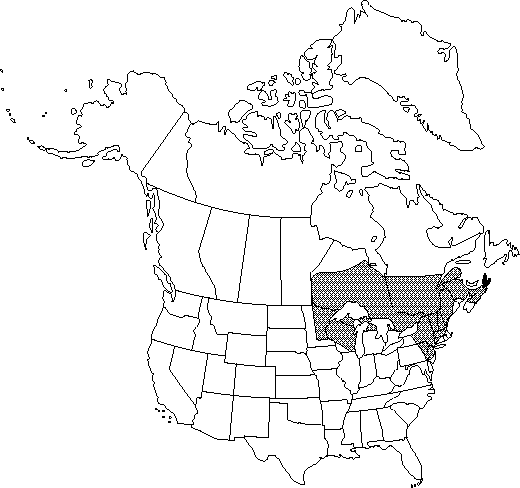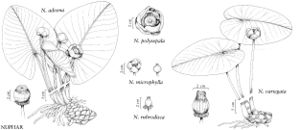Nuphar rubrodisca
Bot. Gaz. 11: 167. 1886 (as rubrodiscum).
Rhizomes 1-2.5 (-4) cm diam. Leaves mostly floating, occasionally submersed; petiole flattened. Leaf-blade often abaxially purple on new leaves, adaxially green to greenish purple, broadly ovate to oblong, 5-25 × 4.5-15 cm, 1.1-1.7 times as long as wide, sinus ca. 1/2 length of midrib, lobes overlapping to divergent and forming V-shaped angle; surfaces glabrous. Flowers 3 cm or more diam.; sepals 5-6, abaxially green to yellow, adaxially often red-tinged toward base; petals broadly spatulate and thin, or notched and thickened; anthers (2-) 3-6 mm, shorter than filaments. Fruit purple, dark-brown, or rarely green, globose-ovoid, occasionally flask-shaped, 1.5-2.5 cm, strongly ribbed, deeply constricted below stigmatic disk, constriction 5-10 mm diam.; stigmatic disk red, 8-14 mm diam., with 8-14 shallow crenations; stigmatic rays 8-15, linear, terminating 0-1.6 mm from margin of disk. Seeds 2.5-3.5 mm.
Phenology: Flowering summer.
Habitat: Ponds, lakes, sluggish streams, sloughs, and occasionally tidal waters
Elevation: 0-400 m
Distribution

N.B., N.S., Ont., Que., Conn., Maine, Mass., Mich., Minn., N.H., N.J., N.Y., Pa., Vt., Wis.
Discussion
Nuphar rubrodisca is generally considered to be a hybrid between N. microphylla and N. variegata because it displays characteristics intermediate between the two taxa. It is reportedly sterile in some areas and completely fertile in others.
Selected References
None.
Lower Taxa
"thin" is not a number.
